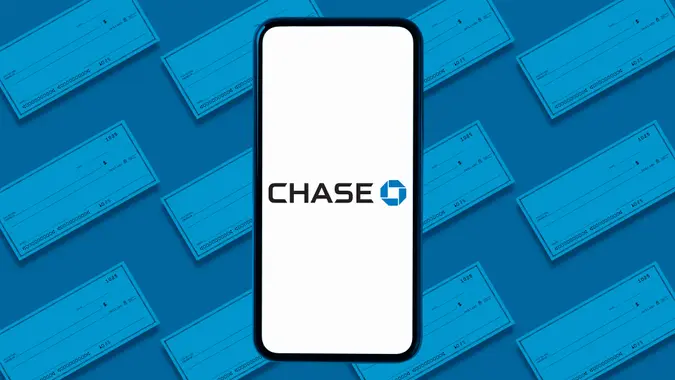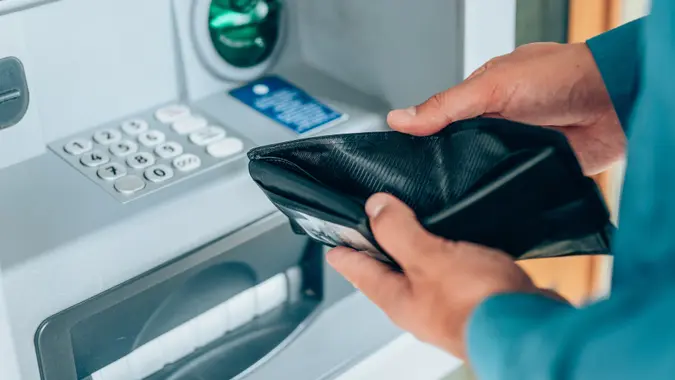How To Balance a Checkbook: Step-by-Step Guide

Commitment to Our Readers
GOBankingRates' editorial team is committed to bringing you unbiased reviews and information. We use data-driven methodologies to evaluate financial products and services - our reviews and ratings are not influenced by advertisers. You can read more about our editorial guidelines and our products and services review methodology.

20 Years
Helping You Live Richer

Reviewed
by Experts

Trusted by
Millions of Readers
Balancing a checkbook might sound like a relic from the past, but it’s still one of the best ways to stay on top of your finances. In this guide, you’ll learn how to balance a checkbook using traditional and modern tools — and why doing so can protect your money.
What Is Checkbook Balancing?
Checkbook balancing is a process where you compare every transaction in your bank account to the transactions you recorded in your ledger.
Before online banking, balancing your checkbook was one of the only ways to ensure accuracy and track your bank balance. But even today, you can use the same concept to manage your money.
Key Terms To Know
- Ledger: Every checkbook has ledger — lined pages where you can track transactions, including ATM withdrawals, purchases and checks you write. If you don’t have one, you can usually get a free ledger from your bank or receive one when you order checks.
- Balance: Before you can balance your checkbook, you need to know the total balance in your bank account. The goal is to ensure that the amount in your account matches the amount you have written in your ledger.
- Reconciliation: When you balance your checkbook, you’re reconciling or fixing any errors. The goal is for the recorded total in your checkbook to match the total amount in your bank account.
How To Balance a Checkbook: Step-by-Step
Balancing a checkbook might sound complex, but it’s actually straightforward and simple. Here are three steps you can follow:
Step 1: Record the Transaction
If you don’t log it, it didn’t happen. The first key to success in balancing a checkbook is simply writing down the transactions.
For anything you spend or deposit, make sure to note and record the balance in your checkbook register. Don’t forget to account for other miscellaneous charges, such as ATM withdrawal fees or monthly subscriptions.
Buy groceries with your debit card? Log the amount in the register and deduct it from the current total. Today was payday? Add the deposit to your balance.
Step 2: Check the Bank’s Statement
Before online banking, consumers had to wait for a monthly statement. With online banking, there’s no wait. You can instantly check the balance in the register against what the app is reporting.
Step 3: Handle Discrepancies
Most financial institutions have a window for when you can handle a discrepancy — this window is typically 30 to 60 days.
Mistakes are costly. If you’re not paying attention, bank fees — especially from out-of-network ATMs — can sneak up on you. Most banks list their fees online, but it’s easy to overlook the fine print. Keeping a running log helps you stay on top of your balance and avoid unnecessary charges, so your money stays where it belongs.
Pro Tip
Balancing your checkbook regularly helps spot fraud early and avoid unexpected fees.
Troubleshooting: What To Do if You Find an Error
You might find errors once you get into a routine of balancing your checkbook. If you made an error, like forgetting to record a purchase or paying a late fee, adjust your ledger and update your balance.
- You can cross out the line if you need to delete an expense.
- If you need to add a new expense, go to the end of the ledger for an empty line.
- Contact your bank directly if you find an error, like a double charge or incorrect fee. Explain the situation and ask to speak to a representative.
- You can also dispute charges online.
How Often Should You Balance Your Checkbook?
You can balance your checkbook weekly, monthly or as transactions occur. Even though it’s a good idea to balance your accounts regularly, it’s even more critical to stick to it.
Quick Tip
Set a recurring calendar reminder to balance your checkbook weekly or monthly — consistency is key.
Digital Tools To Help You Balance a Checkbook
Checkbook balancing can be time-consuming when you do it by hand. It’s worth the hassle for some people, but you can also consider apps and other digital tools to manage your budget.
Here are some of the best budgeting apps and tools that can assist you in your financial planning.
| Tool | Cost | Best For |
|---|---|---|
| Bank alerts | Free | Staying aware of purchases |
| YNAB | $14.99 per month | Beginners and budgeters |
| IOU | Free | Tracking money you lend or borrow |
| BUDGT | Free | Freelancers and gig workers |
| Monarch | $14.99 per month | Automated tracking and visual budgeting |
Why It’s Smart To Keep Receipts
Whether you balance your checkbook manually or you prefer to use a banking app, it’s important to keep receipts. Your receipts are key to reconciling your budget, completing returns and preventing fraud.
Here are simple tools you can use to organize digital and physical receipts:
- Mr. Receipt: This free app can scan and upload paper receipts. It’s an easy way to stay organized and make sure you have what you need. Plus, Mr. Receipt sends reminders about warranties and return windows.
- Get My Receipts: This software can scan your Gmail account and find receipts. Get My Receipts automatically exports receipts to Google Sheets, making it simple to track digital purchases. Users can select a free basic version or a more feature-rich premium version for $69.90 per month.
Avoid These Checkbook Balancing Mistakes
Balancing a checkbook is a long-standing financial practice, but that doesn’t mean you won’t make mistakes. Here are two of the most common mistakes and what you can do to avoid them.
Remember Small Transactions
- Forgetting an expense, even a small one, can make it harder to balance your checkbook.
- Remember to track every transaction, regardless of the amount.
Record Automatic Payments and Fees
- Automatic bill pay can be a lifesaver, especially if you’re trying to pay your bills on time. But you need to remember to track the expenses in your ledger.
- To make it easier, you can schedule your automatic payments for the same day each month and write down all the expenses at once.
Keep In Mind
Don’t forget those small purchases — even $2 snacks can throw off your balance.
Avoid Overdrafts by Balancing Your Checkbook
Balancing your checkbook helps you avoid overdraft fees and negative balances.
For example, imagine you have $50 left in your account before payday. Because you know the amount, you can choose to eat dinner at home instead of eating out.
It might seem like a small decision, but it can have a significant impact on your financial health.
Final Tips for Successful Checkbook Balancing
Knowing where and when your hard-earned dollars are received and spent is the crux of budgeting responsibly. Here are a few tips to make checkbook balancing a habit:
- Log every transaction: Use a checkbook register or app to track every transaction.
- Reconcile regularly: Balance your checkbook at the end of each month to catch errors.
- Watch your spending patterns: Your register can help you spot areas where you’re overspending.
FAQ
Here are the answers to some of the most frequently asked questions about checkbook balancing.- Do I need to balance my checkbook if I don't use checks?
- When you balance a checkbook, you compare your recorded expenses to your bank account balance. Checkbooks come with ledgers that have blank lines for recording transactions. But you can still track your expenses if you don't use checks. You can use an app, budget software or notebook.
- How can balancing help improve my budgeting?
- The process of balancing your checkbook allows you to have a better understanding of your finances and make informed spending decisions. You can examine how you spend money and make changes based on what you learn. It's a free and effective way to improve your finances.
- Is it worth balancing a checkbook in a digital banking world?
- It might be worth it to balance your checkbook, even in a digital world. But even if you don't balance a checkbook in the traditional way, you can still use the practice to improve your finances. Track your spending in a budget app or notebook to learn more about your finances and make positive changes.
Caitlyn Moorhead contributed to the reporting for this article.
 Written by
Written by  Edited by
Edited by 
























